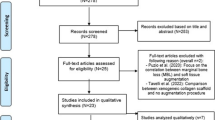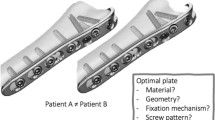Abstract
Bone infections can be challenging to treat and can lead to several surgeries and relapses. When a graft is needed, cavitary bone loss can be grafted with cancellous or cortical bone. Both can be used for grafting. However, the antibiotic releasing capacity of these grafts has not been compared. Which type of bone is best at releasing the most antibiotic has not been well established. The aim of this study was to determine which type of bone is best for antibiotic release when the bone is suffused with antibiotics by the surgeon. The hypothesis is that there would be a difference between the type of bone tested due to different release capacities of cortical and cancellous bone. This was an experimental study. Cortical spongy bone in chips, Spongy bone in chips and demineralized cortical bone powder were compared. For each type of bone, 5 samples were tested. Processed and decontaminated grafts were freeze-dried to be kept at room temperature. The primary endpoint was the amount of vancomycin released by the graft as it affects the concentration of antibiotic around the graft in clinical practice. The procedure for the study consisted of full graft immersion in a vancomycin solution. Then, the liquid was removed with aspiration. In order to measure the quantity of antibiotic released, the bone was put into distilled water in agitation in a heated rocker at 37 °C. After 30 min of soaking, 1 mL of the liquid was removed. The same extraction process was also carried out after 60 min soaking, 2 h, 3 h, 24 h, and 48 h. No differences were found between each type of bone relative to the concentration of vancomycin released at each time of the assessment. There was a significant difference in the weight of the bone with a higher weight for the cortical powder (1.793 g) versus cortical spongy bone and spongy bone (1.154 g and 1.013 g) with a p value < 0.0001. A significant difference was seen in the weight of the bone with vancomycin after the aspiration of the liquid with 3.026 g for cortical powder, 2.140 g and 2.049 g for the cortical spongy bone and the spongy bone with a p value < 0.0001. In daily clinical practice, one can use cancellous bone, cortico-cancellous bone or cortical powder in order to add vancomycin to a bone graft. Our results show the release kinetics of the soaked allografts. With a maximum of 14 mg/mL in the first minutes and a rapid decrease it shows a pattern comparable to antibiotic loaded bone cement. The method used appears favourable for prophylactic use, protecting the graft against contamination at implantation, but is not sufficient for treating chronic bone infection.
Level of evidence
V.


Similar content being viewed by others
References
Anagnostakos K, Schröder K (2012) Antibiotic-impregnated bone grafts in orthopaedic and trauma surgery: a systematic review of the literature. Int J Biomater. https://doi.org/10.1155/2012/538061
Buttaro MA (2012) Bone grafting and two-stage revision total hip arthroplasty. Hip Int 22(Suppl 8):S69–S74
Buttaro MA, Pusso R, Piccaluga F (2005) Vancomycin-supplemented impacted bone allografts in infected hip arthroplasty. Two-stage revision results. J Bone Jt Surg Br 87:314–319
Buttaro MA, Guala AJ, Comba F, Suarez F, Piccaluga F (2010) Incidence of deep infection in aseptic revision THA using vancomycin-impregnated impacted bone allograft. Hip Int 20:535–541
Cao Z, Jiang D, Yan L, Wu J (2016) In vitro and in vivo osteogenic activity of the novel vancomycin-loaded bone-like hydroxyapatite/poly(amino acid) scaffold. J Biomater Appl 30:1566–1577
Coraça-Huber DC, Ammann CG, Nogler M, Fille M, Frommelt L, Kühn K-D, Fölsch C (2016) Lyophilized allogeneic bone tissue as an antibiotic carrier. Cell Tissue Bank 17:629–642
Ebied AM, Elseedy AI, Gamal O (2016) Single-stage revision for periprosthetic hip infection using antibiotic loaded impaction graft. Hip Int 26:573–579
Goormans F, Vranckx J, Herteleer M, Onsea J, Noppe N, Depypere M, Nijs S, Metsemakers W-J (2019) Segmental bone loss of the clavicle due to fracture-related infection: a multidisciplinary challenge. J Bone Jt Infect 4:60–64
Kamra P, Lamba AK, Faraz F, Tandon S (2019) Effect of antibiotic impregnation time on the release of gentamicin from cryopreserved allograft bone chips: an in vitro study. Cell Tissue Bank 20:267–273
Lewis CS, Supronowicz PR, Zhukauskas RM, Gill E, Cobb RR (2012) Local antibiotic delivery with demineralized bone matrix. Cell Tissue Bank 13:119–127
Ornstein E, Linder L, Ranstam J, Lewold S, Eisler T, Torper M (2009) Femoral impaction bone grafting with the Exeter stem - the Swedish experience: survivorship analysis of 1305 revisions performed between 1989 and 2002. J Bone Jt Surg Br 91:441–446
Shiels SM, Cobb RR, Bedigrew KM, Ritter G, Kirk JF, Kimbler A, Finger Baker I, Wenke JC (2016) Antibiotic-loaded bone void filler accelerates healing in a femoral condylar rat model. Bone Jt J 98-B:1126–1131
Shiels SM, Raut VP, Patterson PB, Barnes BR, Wenke JC (2017) Antibiotic-loaded bone graft for reduction of surgical site infection in spinal fusion. Spine J 17:1917–1925
Sweet FA, Forsthoefel CW, Sweet AR, Dahlberg RK (2018) Local versus systemic antibiotics for surgical infection prophylaxis in a rat model. J Bone Jt Surg Am 100:e120
Wei S, Jian C, Xu F, Bao T, Lan S, Wu G, Qi B, Bai Z, Yu A (2018) Vancomycin-impregnated electrospun polycaprolactone (PCL) membrane for the treatment of infected bone defects: an animal study. J Biomater Appl 32:1187–1196
Winkler H (2009) Rationale for one stage exchange of infected hip replacement using uncemented implants and antibiotic impregnated bone graft. Int J Med Sci 6:247–252
Winkler H (2017) Treatment of chronic orthopaedic infection. EFORT Open Rev 2:110–116
Winkler H, Kaudela K, Stoiber A, Menschik F (2006) Bone grafts impregnated with antibiotics as a tool for treating infected implants in orthopedic surgery—one stage revision results. Cell Tissue Bank 7:319–323
Zahar A, Kocsis G, Citak M, Puskás G, Domahidy M, Hajdú M, Antal I, Szendrői M (2017) Use of antibiotic-impregnated bone grafts in a rabbit osteomyelitis model. Technol Health Care 25:929–938
Funding
No funding for this research. RE thanks the SOFCOT (Société française de chirurgie orthopédique et traumatologique) for supporting him during his stay in Barcelona Tissue Bank (Banc de Sang i Teixits), Barcelona, Spain.
Author information
Authors and Affiliations
Contributions
RE participated in the conception, manipulation, writing, correction. DP participated in the conception, writing, correction. SG PL SB AV JCM and OF participated in the conception of the study, the correction and the supervision.
Corresponding author
Ethics declarations
Conflict of interest
RE, DP, SG, SB, JCM have no conflicts of interest. PL, OF, AV are employed by the Barcelona Tissue Bank (Banc de Sang i Teixits), which processed the bone allograft.
Ethical approval
All procedures performed in studies involving human participants were in accordance with the ethical standards of the institutional and/or national research committee and with the 1964 Helsinki declaration and its later amendments or comparable ethical standards.
Informed consent
Informed consent was obtained from all individual family’s participants included in the study.
Additional information
Publisher's Note
Springer Nature remains neutral with regard to jurisdictional claims in published maps and institutional affiliations.
Rights and permissions
About this article
Cite this article
Erivan, R., Lopez-Chicon, P., Fariñas, O. et al. Which type of bone releases the most vancomycin? Comparison of spongious bone, cortical powder and cortico-spongious bone. Cell Tissue Bank 21, 131–137 (2020). https://doi.org/10.1007/s10561-019-09806-2
Received:
Accepted:
Published:
Issue Date:
DOI: https://doi.org/10.1007/s10561-019-09806-2




